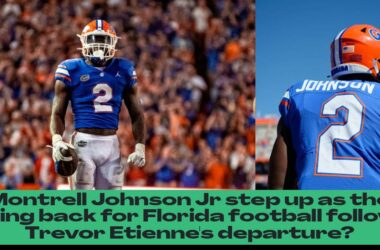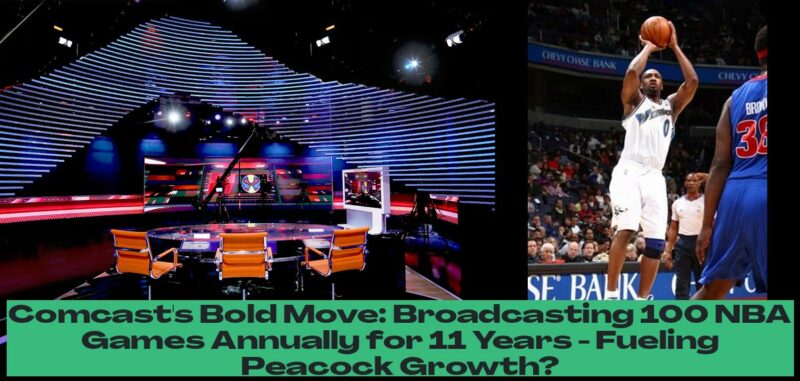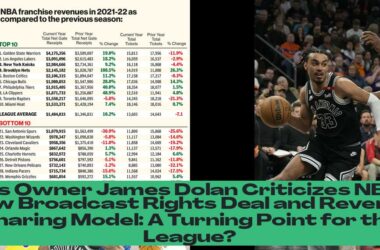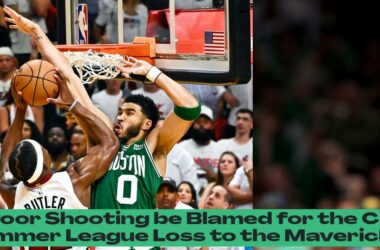Comcast’s Big Bet: 100 NBA Games Per Season for 11 Years
Comcast is making a big bet on basketball, and it’s a gamble that could pay off handsomely. The media giant has announced plans to carry 100 NBA games each season across its NBC network and Peacock streaming service for the next 11 years. This deal is a significant move for Comcast, solidifying their position as a major player in the world of sports broadcasting. By securing the rights to a large chunk of the NBA’s regular season, Comcast is positioning itself to capture a large share of the lucrative sports television market. But why is Comcast so eager to invest in the NBA, and what does this deal mean for fans? Let’s dive into the details.
The deal, which is expected to be formally announced soon, will give Comcast a major presence in the NBA’s regular season schedule. Comcast will be responsible for broadcasting 100 games per season, a significant portion of the league’s regular season schedule. This commitment reflects their belief in the NBA’s continued popularity and growth. But the deal goes beyond simply showing games. Comcast plans to leverage the NBA’s appeal to bolster its own streaming service, Peacock.
The deal includes a significant commitment to Peacock, Comcast’s streaming service. Peacock will be the exclusive home to 50 of the 100 games Comcast will broadcast each season. This strategy is designed to attract new subscribers to Peacock and solidify its place in the increasingly competitive streaming market. The NBA’s popularity, especially among younger audiences, is seen as a major draw for Peacock, which is trying to carve out a niche in a crowded field of streaming services. By offering exclusive content like these NBA games, Comcast hopes to attract viewers and convince them to subscribe to Peacock.
This move represents a significant investment in the NBA by Comcast, and it reflects the company’s belief in the league’s continued growth and popularity. The deal is expected to cost Comcast $2.5 billion per year, a substantial sum that underscores the value the company places on the NBA’s brand. This investment indicates Comcast’s confidence in the NBA’s continued appeal to fans, particularly younger audiences, and their ability to capitalize on the league’s popularity to drive revenue. Comcast’s willingness to spend big on NBA rights demonstrates their commitment to securing a dominant position in the sports media landscape.
For fans, this deal presents both exciting opportunities and potential concerns. On the one hand, the deal provides fans with greater access to NBA games, especially those willing to subscribe to Peacock. This increased availability could be a boon for fans, especially those who don’t have access to traditional cable television packages. However, there are concerns that Comcast’s control over a significant portion of the NBA’s regular season could lead to certain games being prioritized over others, potentially excluding fans from watching specific matchups they might be interested in. The deal also raises questions about the future of the NBA’s other broadcast partners, such as ESPN and TNT.
- Comcast has secured a deal to broadcast 100 NBA games per season for the next 11 years.
- This move solidifies Comcast’s position as a major player in sports broadcasting.
- The deal includes broadcasting games on NBC network and Peacock streaming service.
- Peacock will exclusively air 50 of the 100 NBA games per season, aiming to attract new subscribers.
- Comcast’s investment of $2.5 billion per year reflects their confidence in the NBA’s growth and popularity.
- The focus on NBA content is part of Comcast’s strategy to capture a significant share of the sports television market.
- Comcast aims to leverage the NBA’s appeal, especially among younger audiences, to drive revenue and boost Peacock subscriptions.
Comcast’s Vision: Leveraging the NBA to Fuel Peacock Growth
Comcast is employing a strategic approach to leverage the NBA’s popularity to boost the growth and appeal of Peacock. The company is not only broadcasting games on their flagship NBC network but also making a significant commitment to showcasing them on Peacock, their streaming platform. This strategy is designed to attract new subscribers to Peacock and solidify its place in the increasingly competitive streaming market.
Comcast is strategically utilizing the NBA’s strong appeal, particularly among younger audiences, as a key driver to attract viewers to Peacock. By offering exclusive content like live NBA games, Comcast hopes to entice viewers to subscribe to their streaming service. This is a smart move in a landscape where streaming services are constantly battling for market share. By providing exclusive content, Peacock differentiates itself from other streaming platforms and creates a compelling reason for viewers to choose their service.
The exclusive rights to broadcast 50 NBA games on Peacock represent a significant investment in the streaming platform. Comcast is betting that the NBA’s popularity will translate into higher viewership and subscriber growth for Peacock. This strategy reflects the company’s commitment to investing in its streaming service and its belief that Peacock has the potential to become a major player in the streaming market. By aligning itself with the NBA, Peacock gains access to a dedicated and passionate fanbase, which could potentially drive significant subscriber growth.
Comcast’s move to secure exclusive NBA rights for Peacock demonstrates their understanding of the evolving media landscape. With streaming services becoming increasingly popular, Comcast is strategically positioning Peacock to be a major player in the market. By offering exclusive content like NBA games, Peacock can attract new subscribers and build a loyal fanbase. This strategic investment in Peacock showcases Comcast’s commitment to evolving with the times and remaining a dominant force in the rapidly changing media industry.
The deal with the NBA signifies Comcast’s commitment to investing in their streaming platform and their belief in its potential to become a major player in the streaming market. By offering exclusive content like NBA games, Peacock can attract new subscribers and build a dedicated fanbase, ultimately contributing to Comcast’s overall success in the changing media landscape.
The Impact of Comcast’s Deal on the NBA’s Broadcast Landscape
The addition of Comcast as a major player in the NBA’s broadcast landscape has significant implications for the league’s overall media strategy. The deal, which involves broadcasting 100 games per season across NBC and Peacock, represents a considerable shift in the way NBA games are distributed. This shift could have a ripple effect on the league’s existing broadcast partnerships with ESPN and TNT, potentially leading to a renegotiation of those contracts.
Comcast’s move could trigger a bidding war for the remaining NBA broadcast rights. With Comcast now firmly entrenched as a major player, ESPN and TNT may feel pressure to increase their bids to retain their current rights packages. This could result in a bidding war that ultimately benefits the NBA, driving up the value of their broadcast rights. The league could potentially benefit from increased revenue if they are able to negotiate higher fees from competing broadcasters. However, the increased competition could also lead to a more fragmented broadcast landscape, making it difficult for fans to access all the games they want to watch.
The NBA may be looking to capitalize on the increased demand for their broadcast rights by exploring new opportunities to expand their reach. The league could potentially enter into partnerships with other streaming services or explore new distribution models, such as direct-to-consumer streaming. This could create a more competitive and fragmented media landscape, potentially benefiting fans by providing them with more choices for accessing NBA games. However, it could also lead to a situation where fans are forced to subscribe to multiple services to watch all the games they want.
The NBA’s partnership with Comcast marks a significant turning point in the league’s broadcast strategy. The deal could potentially reshape the media landscape, leading to new opportunities and challenges for both the league and its fans. The league is likely to continue to explore new avenues for broadcasting its games, leveraging the growing popularity of streaming services to reach a wider audience. The NBA’s strategic adjustments to the ever-evolving media landscape demonstrate their commitment to remaining a dominant force in the world of sports and entertainment.









